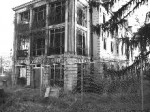
Death, although a resultant of living, is typically viewed from afar by today’s society. One would assume that something as impending, and morbid, as death would arouse more curiosity and interest. However, in general, people do not wish to talk about or even think about death. Professor Laura Cruz created and teaches History 185: Death and Dying in the Western Civilization. Through this course, Professor Cruz hopes that her students will gain a general knowledge of the history of death and also allow for personal reflection.Professor Cruz described the construction and aims of her course in an article written and submitted to the Academic Exchange Quarterly Summer 2005:”My task was to create a freshman-level humanities course, incorporating history and literature, to fit into a liberal studies/general education curriculum at a medium-sized regional comprehensive university. I knew from experience that most of the students considering enrollment in the course would have no interest or background in history or literature. I chose to create a course entitled “Death and Dying in Western Civilization” in order to capitalize on the apparent drawing power of including a taboo subject, death, in the title and subject matter. It was my intention to use ideas and representations of death to trace larger historical changes, to teach skills of historical interpretation, and to promote lively and engaging classroom discussions.”Although there are courses that discuss death, HIST 185: Death and Dying is unique, not just to Western Carolina University, but to universities throughout the United States because it emphasizes the development of attitudes towards death in the Western Civilization. Professor Cruz provides a main theme for the class that is derived from Phillippe Aries’ book Hour of Our Death, and asks, “Did people die better in the past?” From this paramount theme, the course is broken into four sections in which students explore a variety of ideas and literature pertaining to the effects, development of attitudes, and understanding of death. Unlike most history classes, HIST 185 does not move in chronological order, but instead, information is taught in clusters that provide a general driving theme for each section.”Death as a Journey” is the title of the opening section of the course. In this section, students explore readings from the Egyptian Book of the Dead and read sections of the Rig Veda (a book of hymns from the Hindu Vedas). Students examine the idea of reincarnation held by the Hindu and Buddhists and discuss the afterlife, Moksha and Nirvana, of both beliefs. Ideas of different cults and beliefs in the undead, such as vampires and ghost, are presented to the class. Ghost hunters and other guest speakers are brought in to share their personal accounts and give information pertinent to this particular section. A field trip is taken to explore a local haunted house in order to allow students to development their own ideas of the undead.”Death as Judgment” is the title given to the second section of the class. The histories of Heaven and Hell, along with Christian perceptions of death, are presented to the class. Epidemics, suicide, and genocide are explained, and students discuss how these things were judged in different societies. During this section the students are asked to create an Ar0073 Moriendi. These were books written in the Middle Ages and were aimed to teach people how to die well. This project allows students to compose a modern and personal version of a book telling others how to die well. Readings from “Death as Judgment” include Dante’s The Inferno and Robert Louis Stevenson’s The Suicide Club. Another notable work that the class looks at in this section is a comic book titled MAUS: A Survivor’s Tale, created by Art Spiegelman, that depicts the true story of the Holocaust.”Death is Commemoration,” the third section of HIST 185, introduces students to the practices and ideas of grief and mourning employed by different cultures. Under “Commemoration,” students explore how cultures memorialize the dead. Examples of this idea are presented to the students by discussing roadside memorials, war memorials, and pet cemeteries. These examples and ideas lead students to a better understanding of the attitudes held by different cultures towards death. The evolution of local ideas of death and dying are discussed through several readings and class discussions. Other works used in this section come from Edgar Allen Poe and Maxim Gorky.”Death as Pornography” closes out the course by discussing how death is considered by many in today’s society as being forbidden or taboo. The idea that life is bleak and therefore has no meaning is presented to the students and discussed. Mortuary science, the preparation of dead bodies for ceremonies, is reviewed and a trip to the body farm is taken to familiarize students with the anthropology aspect of death. Students examine the different ideas of cremation and burial and also take a trip to a local funeral home. Discussions are held that talk about serial killers and their fascination with death. Beth Harris, a former student from Professor Cruz’s Death and Dying course, commented, “I liked learning about serial killers and their minds and what makes a person that way.” Professor Cruz touches on ideas such as transhumanism (the philosophy of overcoming human limitations to avoid death), murder ballads, and the hospice movement, and she speculates what the attitudes towards death and dying will be in the future.When Professor Cruz was asked why she decided to teach this class, she replied, “It reflects my research.” Professor Cruz has done extensive research on suicide in the Netherlands and remarks that this was a driving force in why she created and teaches History 185: Death and Dying in the Western Civilization. She commented that this is her favorite class to teach, but because of the subject matter, it takes great emotional strength and control to do the course justice.The subject matter of this course is not intended for everyone, and not just anyone should sign up the class. Professor Cruz addresses how she deals with this situation in her article submitted to the Academic Exchange Quarterly Summer 2005:”In order to make sure that students would know what they were getting into, I prepared an introductory lecture where the most sensational images and ideas flashed relentlessly across the screen. I warned them [the students] that the course was not for the squeamish, nor for the closed-minded. The syllabus contained a clause about subject matter that could be upsetting and what to do if you felt that way. I divided the written work into a portfolio arrangement so that students who were not comfortable with some assignments, such as the visit to the morgue, could substitute other assignments.”Through a variety of lectures, guest speakers, and field trips, History 185 students are able to develop their own ideas and understandings of different ideas and concepts. Students are given the opportunity to explore different ideas and offer their own views in an unbiased and open environment. By the end of the course, students should be able to give an answer and supporting reasons to the main theme presented to them, “Did people die better in the past?”People often try to shelter themselves and others from death. Parents prevent kids from seeing death on television and even tell their children that the family pet has simply runaway when it is actually buried two feet in the ground. Euphemisms are used when talking about death and are just another form of sheltering that people use to separate themselves from death. Professor Cruz asks the question, “Is this healthy?” Separation from death obviously has benefits, such as not dwelling on death, but what happens when a person comes to face death?Is it possible for a course on death and dying to teach us how to better understand and live our own lives?”Men fear death as children fear to go in the dark; and as that natural fear in children is increased by tales, so is the other.” – Francis Bacon






